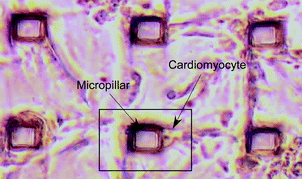Demonstration of a PDMS-based bio-microactuator using cultured cardiomyocytes to drive polymer micropillars†
Abstract
Natural cellular functions are increasingly exploited for integrated chemical systems such as biochemical reactors and biosensors. We propose to utilize the intrinsic mechanical function of cardiomyocytes, converting chemical energy into mechanical energy. In this report, we demonstrate the working principle of our proposed poly(dimethylsiloxane) (PDMS) based cardiomyocyte bio-microactuator using fabricated PDMS micropillars driven to repetitive motion by attached pulsating cardiomyocytes. Sheets of PDMS embedded with an array of micropillars were fabricated and modified for cardiomyocyte attachment in culture. Primary neonatal rat cardiomyocytes were cultured on the array, attaching to the micropillars and substratum successfully, and exhibiting their typical spontaneous, pulsatile phenotype. Micropillars beat with the coupled cells spontaneously without any triggers. The beat frequency was 1.4 Hz at 37 °C and the displacement of the top of the pillar that beat most strongly in our observation was 2.8 ± 0.2 µm. From this result, contractile forces of cultured cardiomyocytes were estimated to exceed 3.5 µN. The estimated force is far greater than that of a previously described hydrogel-based cardiomyocyte bio-microactuator (K. Morishima et al., in Micro Total Analysis Systems 2003, ed. M. A. Northrup et al., The Transducers Research Foundation, San Diego, CA, vol. 2, pp. 1125–1128). PDMS compatibility as a base material for bio-microactuator design using cultured cardiomyocytes was verified. This PDMS-based cell microactuator worked for about one week without exchange of the culture medium, and this system could be developed for various purposes in the future as self-actuated and efficient mechanochemical transducers without external energy source requirements.


 Please wait while we load your content...
Please wait while we load your content...